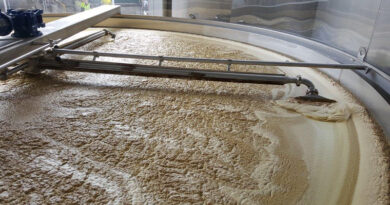Sulfur, sulfites and sulfides: a primer
Pictured above: Vancouver harbour has a famous sulfur pile. It’s stored here after arriving as a by product of oil extraction in Alberta, and is then loaded onto ships and sent to its various destinations.
Let’s talk about sulfur and wine. This is a topic that causes a lot of confusion, and the chemical terms sulfur, sulfites and sulfides are often used in wine talk, sometimes by people who aren’t all that clear what they are referring to.
First, sulfur. You can also call it sulphur, but the preferred chemical name is sulfur. [The International Union of Pure and Applied Chemistry (IUPAC) are responsible for issues of naming chemical elements and compounds, and they decided that it’s sulfur with an f a while back.] This is one of the chemical elements, number 16 and the fifth most common on earth, and it’s yellow in colour.
It’s used in viticulture as a spray to deal with powdery mildew, which is a big problem in vineyards worldwide. Sulfur can be applied as a dust or as a wettable version, where it is made soluble and then sprayed in liquid form.
It is a contact fungicide that works preventatively, but it’s not curative. That is, it stops the fungus establishing itself on the vine, but if the fungus is already established, sulfur isn’t going to correct the problem. Sulfur has traditionally been used alongside a copper sulfate/slaked lime combo called Bordeaux mixture, which is used to deal with downy mildew. This is also a contact fungicide. When these are washed off by rain, they need to be reapplied. Both sulfur and copper are allowed in organic viticulture.
Elemental sulfur also used to be used in the winery, and in a few places still is, as sulfur wicks. When these are burnt, usually inside a barrel, they produce sulfur dioxide, which is a gas that acts as a microbicide killing unwanted bacteria and yeasts. It dissolves in wine, and there are legal limits on the concentration at which it can be used. It also binds to chemicals produced during the first stage of oxidation of wine, thus protecting wine from the harmful effects of oxidation.
Sulfur dioxide is also referred to as ‘sulfites’, and it is now normally added to wine in the liquid form of potassium metabisulfite, which releases sulfur dioxide. It’s possible to dose accurately using this method, whereas burning a sulfur wick is incredibly imprecise.
Sulfur dioxide is also produced by yeasts during fermentation, sometimes in sufficient quantity that even if none is added, the wine needs to be labelled as ‘contains sulfites’.
So, we’ve dealt with sulfur (used in the vineyard), and sulfites (used in winemaking), so what about sulfides?
Whereas sulfites are oxidised sulfur-containing compounds, sulfides are reduced sulfur compounds. They are one of the groups of compounds that are classed as volatile sulfur compounds that cause the wine fault widely known as reduction. As well as sulfides, this group also includes mercaptans (also called thiols) and thioesters. The most famous sulphide is hydrogen sulfide, a gas made by yeasts during fermentation. If the yeasts are stressed they can make enough of this so that the wine smells of boiled eggs and drains.




